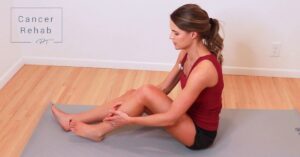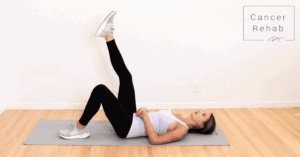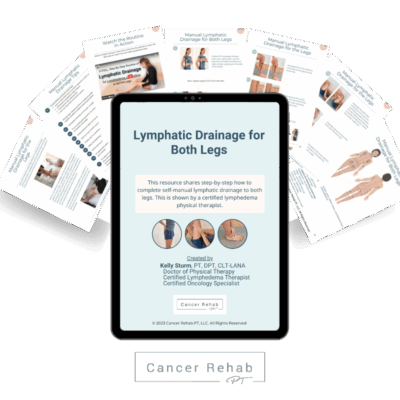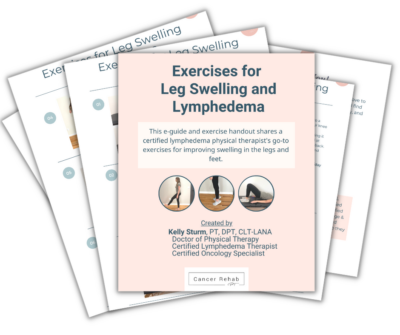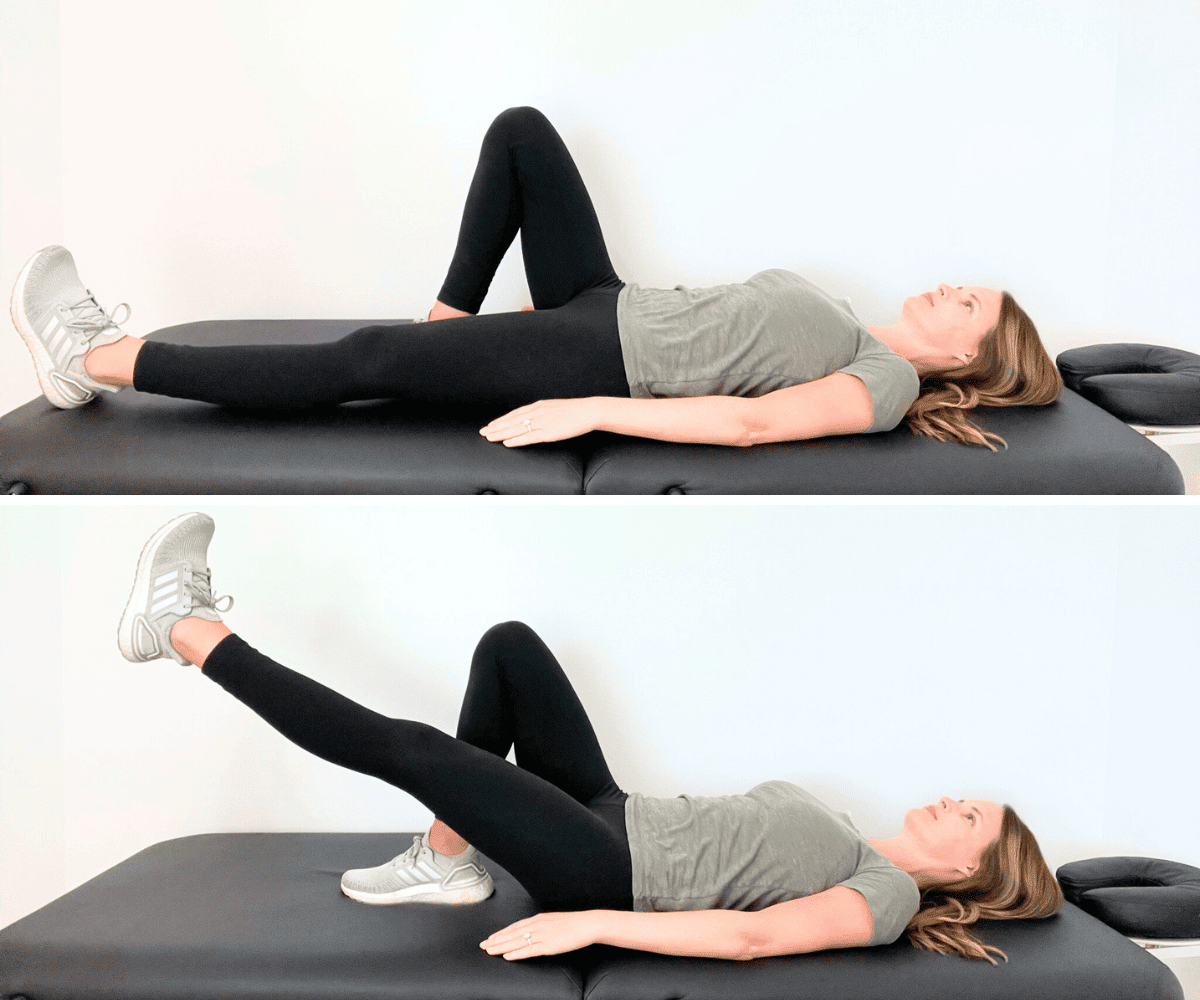1Lymphedema is a chronic medical condition that occurs when there’s an accumulation of lymph fluid, usually in the arms or legs. The lymph fluid buildup leads to swelling and discomfort. Lymphedema is a common condition and affects up to 250 million people worldwide.
Lymphedema leg exercises can help you reduce swelling and support your lymphatic system. A lymphedema diagnosis doesn’t mean that you have to live with discomfort forever. With self-management and physical activity, you can minimize symptoms and get back to living a life you love.
Why Does Exercise Help with Leg Lymphedema?
Lymphedema commonly affects the legs, resulting in swelling, discomfort, and reduced mobility.
You may have developed leg lymphedema as a result of cancer treatment or surgery (secondary lymphedema) or genetic factors (primary lymphedema). In both cases, physical activity helps effectively manage the symptoms.
So, why does physical exercise help with leg lymphedema? Simply put, your muscles act as pumps for your lymphatic system. When you activate them, they put pressure on the affected limb(s) and help move buildup lymphatic fluid out of the area.
A consistent exercise routine helps you stimulate your lymphatic system and keep it healthy.
The Benefits of Exercise for Leg Lymphedema
- Lymphatic Drainage: Muscle contractions that naturally happen during exercise help move stagnant lymphatic fluid, reducing leg swelling.
- Joint Mobility and Flexibility: Lymphedema can lead to stiffness and limited range of motion in the legs, but incorporating exercise into your daily routine helps you reduce discomfort.
- Muscle Strength: Strong leg muscles support your lymphatic system and your body’s overall stability and functionality.
- Weight Management: Staying at your healthy weight is an important part of lymphedema management, and regular exercise can help you lose unwanted pounds.
- Mental Health: Physical exercise reduces stress and improves your mood, which is essential when living with a chronic medical condition like lymphedema.
Now that you understand the benefits of exercise for leg lymphedema, let’s go over exercises that can help you reduce leg swelling. You can also try these arm exercises if you have lymphedema in your arms, neck, or shoulders.
7 Lymphedema Leg Exercises to Reduce Swelling
When it comes to managing leg lymphedema, almost all types of physical activity are beneficial, including walking, swimming, and biking. To help you get started, here is a simple exercise routine you can do at home with no equipment required. Watch my YouTube video to follow along!
1. Bridges
Bridges is one of the most effective exercises for leg swelling. Lay down on your back with your knees bent and your feet flat. Engaging your core, gently lift your hips a few inches off the ground. Then move them back down. Repeat this movement 10-15 times.
Do what feels good for you. If it’s challenging to move your hips, try lifting them just an inch off the ground. Any level of activating your muscles will be beneficial, so simply do what feels comfortable to you.
2. Leg Raises
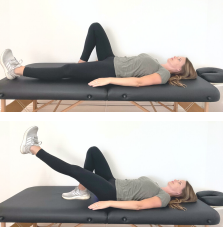
Laying on your back, extend one leg straight and keep the other leg bent. Keeping your core engaged, slowly raise your leg. Then move it back down to the floor. Repeat this movement 10-15 times. Once you’re done, do the same exercise with your other leg.
You can lift your leg as high as it feels comfortable for you. Remember to keep your back nice and flat on the ground and consistently engage your core.
3. Heel Slide
Lay down on your back and bend your knees. Keeping one knee bent, slowly slide down your heel and extend your leg all the way. Then, slide your heel back up, bending your knee again. This exercise activates the muscles in your thigh and knee as well as your calf muscles. Repeat 10-15 times.
Keep the movement nice, gentle, and controlled. Once you’ve repeated the exercise 10-15 times with one leg, switch it up and repeat on the opposite side.
4. Hip Abductors
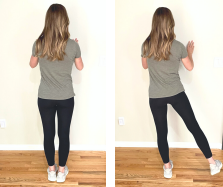
Find a stable surface to hold on for balance, like a countertop or a dresser. Standing up nice and tall, move one leg to the side and bring it back to the center. Keep your body straight and don’t slump into your hip. Repeat this exercise 10-15 times and repeat on the opposite side.
You should feel your hip muscles during these exercises, but remember to keep it gentle and listen to your body.
5. Mini Squats or Sit to Stands
Standing at a stable surface, such as a countertop or a dresser, squat down a few inches and come back up to the start position. The movement should feel like you’re going to sit down in a chair. Make sure to send your hips back and don’t let your knees go over your toes. Repeat 10-15 times.
If this movement feels too challenging, you can do a variation of this exercise. Put a chair behind you and go from sitting to standing, working the same muscle groups. This exercise is great for moving backup fluid toward healthy lymph nodes and lymph vessels.
6. Toe and Heel Raises
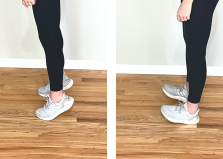
Toe and heel raises are great for stimulating the ankle area and improving your lymph circulation there. Holding on to a stable surface (such as a countertop), lift up and down alternating between your toes and your heels. Repeat 10-15 times.
7. Bicycle Kicks
Full leg motion is a great way to reduce leg swelling and build up strength. Standing straight and holding on for balance, lift one of your legs in a marching motion and kick your knee straight out. Come all the way around to kick your heel back. Then, come back to the start position.
Repeat this exercise 10-15 times on one side. Then, move to the opposite side. Make sure to hold your posture nice and tall, activating the blood flow throughout your entire leg.
💪That’s it! Now you have a practical of exercises to help manage leg lymphedema and minimize the swollen area.
If you’re looking for more exercises, learn more about my program Lower Body Lymphedema Rehab.
Safety Considerations for Lymphedema Physical Exercise
Physical exercise is a great way to manage leg lymphedema, but it’s important to listen to your body and avoid doing too much too fast.
Start with low-impact exercises (like the ones I share with you above!) and gradually increase intensity and duration as your tolerance improves. Stay hydrated and incorporate rest between your workouts.
You can also consult with your lymphedema specialist before initiating an exercise program. They can help you assess your physical condition and provide personalized recommendations for exercises and routines.
Staying Consistent with Exercises for Leg Lymphedema
Consistency is one of the most important aspects of managing lymphedema.
Regular physical activity helps maintain lymphatic circulation, reducing fluid buildup and swelling in the affected areas. It also helps you build up your strength over time and provides consistent boosts to your mood.
It can sometimes feel like lymphedema management is taking over your life, which makes it hard to stay consistent. Remember that exercising for just 10-15 minutes a day has great benefits. You can do your lymphedema leg exercises at home and don’t need any special equipment.
Lymphedema Leg Exercises FAQs
What’s the best exercise for lymphedema in the legs?
There’s no one single best exercise to manage leg lymphedema. In other words, there are so many potential exercise routines for you to try! Low-impact activities, such as walking, swimming, and cycling, can be great options. If you’re working out at home, try exercises like bridges, leg raises, and bicycle kicks. I share many exercises you could try in this guide!
Does walking help leg lymphedema?
Yes, walking can be highly beneficial for lymphedema management. When you walk, the rhythmic contraction and relaxation of your leg muscles act as natural pumps. This helps move the lymph fluid out of the swollen areas. Don’t feel the pressure to go for long walks or cover high mileage. Walking for just 10-15 minutes a day is still beneficial!
How can I increase lymphatic drainage in my legs?
There are many tools available to you to help improve circulation and reduce swelling in your legs. Physical exercise, lymphatic massage, compression therapy, and elevation are just a few of the techniques that you can incorporate into your lymphedema self-care routine.
Can lymphedema go away with exercise?
Physical activity is highly effective for lymphedema management, but it typically cannot cure lymphedema or make it go away completely. Lymphedema is a chronic condition, but it doesn’t mean that you have to live with limitations forever. Self-management techniques – including physical exercise – help you minimize the symptoms and live your life more fully.
What should you not do with lymphedema in your legs?
Certain activities or habits can make your leg lymphedema symptoms worse. Sitting or standing for long periods, wearing tight clothing, being in extreme cold or heat, high-impact activities, skin injuries, and eating too much salt are some factors that can have a negative impact. Try to avoid them. It’s also important to know what self-care tools and techniques you can use in case of a flare-up.
More Lymphedema Leg Exercises and Resources
Managing leg lymphedema is a personal journey. There are many effective ways to reduce swelling and discomfort, but you need to be patient and build your lymphedema self-management toolbox. Physical exercises, compression therapy, and bandaging routines are just some examples of ways to manage lymphedema.
To help you build an effective routine, I created a comprehensive resource called Lower Body Lymphedema Rehab. Inside, you’ll find education and practical tools to reduce lymphedema symptoms and maximize your life. Learn more about it!

